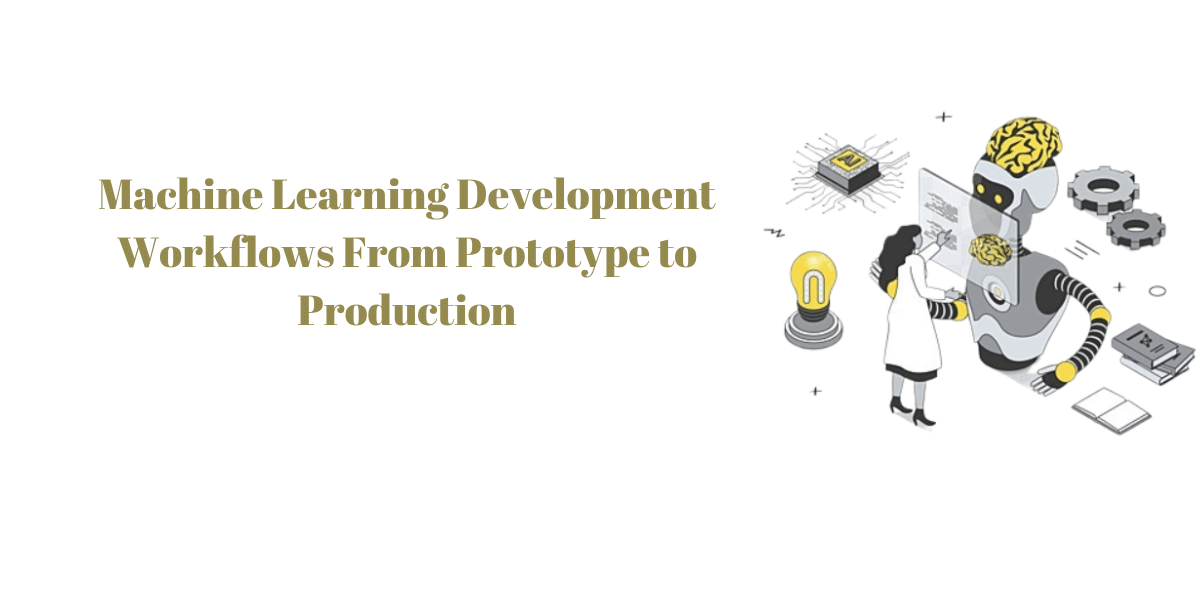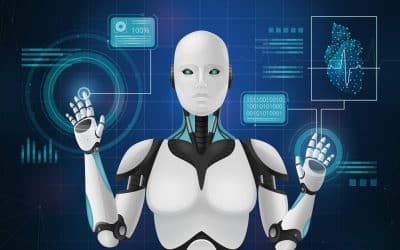In the constantly changing world of machine learning development, transitioning from the prototype stage to the production phase is an essential stage that requires skill, precision, and strategic decisions. This process, typically brimming with challenges and complexities, requires a deep knowledge of transitioning from experiments to saleable, efficient, effective systems.
Consulting expertise inspires, providing suggestions, best practices, and solutions for navigating the complex terrain of ML workflow creation. As more and more organizations realize the necessity of deploying solid models of ML that can be used in real-world scenarios, seamless and efficient integration is essential.
This blog lays out the various challenges in this endeavor and shows how informed ML development services can help make way for the most efficient ML workflow that ensures the smooth transition of prototypes into ready-for-production solutions.
Significance of Moving Between Prototype and Production
The significance of transferring between prototype and production within Machine Learning (ML) cannot be overemphasized since it represents the crucial point when experimental models transform into operational, scalable solutions. While prototyping is a great way to investigate concepts and algorithms, the true power of ML can be realized when models that meet actual needs are seamlessly integrated into production environments. This is crucial for businesses wishing to realize the full capabilities of ML applications.
Beyond prototypes, algorithms demonstrate their theoretical value and utility in influencing decision-making processes, automating tasks, and increasing the overall efficiency of business processes. The process involves addressing scalability, effectiveness, and reliability issues and is challenging yet crucial. The successful deployment of production systems involves careful considerations that range from optimizing data pipelines to modeling understanding and security compliance.
Expert advice from consultants is essential when navigating this complicated journey, offering advice on the best practices, monitoring performance, and constant improvement. In the end, the value is in the transformative power in ML models when they are applied to real-world scenarios, changing industries and defining the future of technological innovation. The transition of prototypes to manufacturing marks the moment when potential theoretical ideas become tangible benefits, confirming the power of ML to act as an agent of positive change across a variety of fields.
Understanding the Role of Prototypes in ML Development
Understanding the importance of prototyping for Machine Learning (ML) development is crucial to laying the foundation for robust and efficient models. Prototypes function as experiments which allow data scientists as well as designers to evaluate hypotheses, assess algorithms, and test the performance of models in controlled conditions. The initial prototypes provide an actual model of the proposed ML solution, offering insight on its potential efficiency. Prototyping is the crucial stage in which ideas are transformed into functional models, helping in determining the best methods while evaluating various methods and parameters.
It is a vital testing platform for refining and adjusting models prior to their use into real world applications. Furthermore, prototypes help facilitate collaboration and communication between multidisciplinary teams, allowing people involved to see how to implement the ML solution and collect feedback at the beginning of the process of developing. Understanding the function of prototypes requires recognizing their dual purpose of proving the ML concept and acting as a tool to communicate for teams with cross-functional roles.
As prototypes grow and learn from repeated testing can contribute to the improvement of precision, efficiency, and flexibility. Thus, understanding the importance of prototypes is crucial not just to refine algorithms for ML, but also making sure that the transition from prototypes to production-ready systems goes smoothly and optimized for the impact of real-world use.
Problems of Migrating from Prototypes to Production
The transition from prototypes to commercialization in the field of Machine Learning (ML) is an intricate process that is brimming with issues that require careful analysis and strategically planned mitigation. One of the main issues is scalability. Although a prototype can be able to perform admirably in controlled environments, ensuring that the model is able to cope with the complexity and volume of data from the real world is of paramount importance. The problem extends to improving the efficiency of computational infrastructure and resources for effective and reliable operations at scale.
In addition, ensuring that models are reliable and consistent across different environments is a major issue, given that the process involves the transition from controlled experiment settings to diverse, dynamic production systems. Another major obstacle involves the integration of an ML model in existing processes and systems, which requires seamless aligning with operations processes. The requirement for the understanding and explanation of ML models is heightened at this point, as regulators and stakeholders demand a knowledge of the models’ decision-making process. Security and compliance concerns create a new layer of complexity that requires strong measures to safeguard sensitive information and adhere to the requirements of regulatory bodies.
The nature of data that is temporal poses challenges due to model drift. In other words, the model’s performance decreases as time passes because of changes in the fundamental data distribution. To address these issues, it is necessary to adopt an integrated approach that involves not just data scientists, as well as domain specialists as well as IT experts. The complexity of this change requires a comprehensive approach, which includes organizational, technical and operational elements. This highlights the necessity of using experts in consulting to help speed the process from concept to production efficiently.
Leveraging Consulting Expertise for Seamless Workflow Integration
Utilizing the expertise of consultants is crucial to ensure seamless workflow integration within the multifaceted world that is Machine Learning (ML). Consultants bring specific knowledge and expertise to the table providing invaluable insights that cover technological, organizational, as well as strategic aspects. From the beginning consultants play an integral role in analyzing the specific needs and issues of a company’s ML workflow. Their knowledge aids in creating the right roadmap and ensures that the process of transitioning from the prototype stage to production is in line with the larger business goals.
Technology-wise consultants offer guidance on deciding and maximizing the best tools and frameworks to ensure the efficiency of ML operations. Their knowledge of the best practices for modeling deployment, scaling and monitoring are a significant part of the process of integration. In terms of organizational aspects, consultants encourage collaboration between teams across functional areas, helping bridge that gap between data scientist’s IT specialists, as well as other business stakeholders. Their strategic direction helps align ML initiatives with business objectives improving the efficiency of the overall workflow. Consultants also assist in the complexities of regulatory compliance, and ensure that the workflow is adherent to the standards of compliance and regulations regarding data governance.
The process of iterative ML software development gains from the continual feedback and optimization offered by consultants’ expertise. By working together consultants don’t just help solve issues but also help to establish an attitude of continual improvement. The essence of consulting is that leveraging their experience facilitates a comprehensive and adaptive process of integration that transforms the obstacles of workflow change into opportunities for growth and innovation in the ever-changing area of ML.
Key Considerations in ML Workflow Optimization
Enhancing Machine Learning (ML) workflows is a complex process and requires careful analysis of aspects that span operational, technical and strategic dimensions. The most important consideration is the quality of data as well as preprocessing it to ensure that data is accurate, clean and well-structured data is vital to ensure modeling performance. Scalability is another crucial factor, requiring the creation of ML workflows that are able to handle the growing volume of data and demands on computational resources.
Model selection and choice of architecture are crucial which require careful thought to achieve the right balance between interpretability and complexity. Workflow optimization is also about tackling problems related to model development and deployment, where effective methods, parameters tuning and effective deployment strategies play a crucial role. Regular monitoring and evaluation are crucial to identify the performance decline, adjusting to the changing distribution of data and maintaining the effectiveness of models in the course of time.
Collaboration between teams across disciplines is a crucial consideration in the organization as effective communication between data researchers, domain experts along with IT experts ensures the ML workflow is in sync with the business goals. A strategic alignment with the overarching goals of the business is essential to getting meaningful results out of ML initiatives, highlighting the necessity of a seamless implementation of ML workflows into larger organizational strategies. Furthermore, compliance with regulations and ethical standards should be integrated into the structure of ML workflows to ensure the responsible and accountable utilization of models and data. In the end, optimizing ML workflows requires a holistic method that integrates technical proficiency as well as organizational alignment and strategic thinking, in which every aspect plays an important part in creating a harmonious and effective ML ecosystem.
Prototyping Best Practices in Machine Learning
Prototyping in Machine Learning (ML) is the critical phase of testing models to test concepts and improve methods before moving to production. In order to ensure the effectiveness of prototyping, adhering to the most effective methods is crucial. The first step is to establish specific goals as well as success standards is essential to determine the process of prototyping. This requires understanding the particular issue to be resolved as well as defining success metrics and aligning them with larger business objectives.
A focus on iterative approaches lets you continuously refine your model that allows data scientists to explore multiple hypotheses, alter parameters and improve model performance slowly. The use of thoughtful feature engineering is a crucial method to follow, since selecting and changing relevant features can impact the accuracy of the model. In addition, it is important to include representative datasets that reflect the variety of real-world situations, which improves the model’s generalization. Documentation of each step is vital, providing information on data processing as well as the selection of models and reasons behind decisions made during the process of prototyping. Collaboration among team members, which includes experts in the domain as well as data scientists and others, helps to create a common knowledge regarding the prototyping’s strengths as well as weaknesses.
Testing and validation rigorously against data from training as well as untested datasets help ensure that the model is performing well. Furthermore, maintaining control over the version and reproducibility assists to track changes and improves accuracy, encouraging collaboration and ensures consistency in prototyping workflows. Utilizing the best practice guidelines for ML prototyping doesn’t just speed up development times but also creates the base for seamless transition from prototypes to solutions that are ready for production.
Bridging the Gap: Prototyping to Production
Making the transition between prototyping and production Machine Learning (ML) represents an important point at which experimental models transform into more scalable and efficient solutions. This requires overcoming obstacles that arise from the transition between controlled and real-time application to ML algorithms. One of the most important aspects is the ability to scale; models that work well in initial tests need to be able to adapt seamlessly to greater numbers of data sets and more processing requirements in production.
Integrating with existing processes and systems is essential which requires integration strategies that integrate with the ML solution with the operational processes. This requires the consideration of concerns of reliability, consistency and interoperability as models transition from controlled settings to various production environments. Collaboration among teams that are interdisciplinary that include experts in data science, IT specialists, and experts in domains, is crucial to ensuring the successful integration. In addition, maintaining the integrity of the data pipelines, optimizing computational resources and ensuring the security of models are crucial factors. Consulting expertise plays a crucial part in guiding companies through this complicated process, providing tips on best practices, strategic decisions, and constant improvement.
The seamless transition from prototyping to production is not merely a technical problem but a broad project that requires alignment between the organization with strategic thinking, foresight and a collective approach to unlock the real capabilities for ML techniques in applications that are real. The ultimate goal is to bridge this gap and ensure that ML prototypes become efficient and effective tools that are able to contribute significantly to business goals.
Importance of Consulting in ML Workflow Efficiency
Consulting is essential to Machine Learning (ML) workflow efficiency is vital, given the complex and ever-changing character of ML development. Consultants have specialized expertise and expertise that are beneficial at all phases that are involved in the process. From the initial conception to the implementation of models in production consultants offer guidance on strategic issues along with best practices and information that can significantly improve the effectiveness in ML workflows.
They play an important role in analyzing the unique requirements and goals of an organization, and aligning ML initiatives with the larger business objectives. With regards to technology, they assist in the selection of the appropriate frameworks, tools and infrastructures for the best ML operations. Their knowledge aids in the improvement models, pipelines for data as well as deployment methods, assuring an efficient workflow that is efficient and adaptable. In terms of organizational aspects Consultants facilitate collaboration among various teams, which includes the data scientist, IT professionals, and business stakeholders. This type of collaboration does not just improve communication, but helps ensure that ML solutions are in sync with the company’s goals. Consultants play a key role in addressing compliance issues with regulatory agencies and ethical concerns, ensuring the privacy of data and minimizing the risk.
They also provide constant assistance in monitoring and enhancing workflow efficiency, helping to create the development of a culture that is constantly improving and flexible. The essence of consulting is that it is a catalyst for ML efficiency in workflows, providing an extensive and strategic plan to maximize the impact of ML initiatives for organizational success. The ever-changing and dynamic world of ML requires companies to use the power of consulting to manage complex issues and realize all the potential in your ML workflows.
Navigating the Complexities of ML Model Scaling
The challenge of navigating the complexity involved in Machine Learning (ML) model scaling is an important task when organizations are trying to implement advanced models in real-world scenarios. Model scaling entails improving ML algorithms to cope with greater amounts of data, more computation demands, as well as diverse production environments. One of the main problems is finding a balance between efficiency and complexity of the model because models that are too complex could be prone to bottlenecks in performance that limit the ability to scale.
Effective scaling requires careful consideration of the hardware and infrastructure to ensure that the computational resources meet the increasing requirements of larger data sets and more complex algorithms. In parallel, dealing with issues that are related to parallelization and distributed computing is crucial for seamless scaling, as businesses seek to leverage the potential that distributed computing systems can provide to speed up data processing, and speed up modeling training. Data processing and feature engineering are crucial in scaling, and require strategies that are able to handle the growing quantity and variety of data from the real world.
In addition, maintaining model interpretability and comprehensibility during the process of scaling is essential, particularly in fields where transparency is essential for regulatory compliance and compliance. ML Consulting services are essential in navigating these challenges, offering insight into the most appropriate scaling strategies as well as optimizing algorithms and aligning scaling strategies to business goals. Achieving success in navigating ML model scaling issues will not only result in improvements in performance but also provides the basis to deploy models that are able to withstand the rigors of the production environment, eventually aiding in the successful incorporation of ML solutions into the workflows of operational processes.
Strategies for Effective ML Model Deployment
The effectiveness of Machine Learning (ML) model deployment is an important process that requires careful planning and precise execution to transform theoretical concepts into solutions that can be implemented. An essential strategy is to comprehend the environment of deployment thoroughly taking into consideration factors like computer resources, infrastructure and operational limitations. Microservices and containers can improve the flexibility and scalability of deployment, which allows for seamless deployment across a variety of environments. Continuous integration as well as continuous deployment (CI/CD) pipelines can speed up the process of deployment, ensuring the speedy and continuous delivery of the latest models.
A/B testing techniques allow companies to assess the performance of their new models to existing models in real-world situations, allowing them to make data-driven decisions about the selection of models. Making sure that there is a version control system for both code and models is vital for keeping track of changes and helping rolling back in the event of problems. Monitoring and logging techniques give insight into the performance of models in detecting any anomalies, as well as ensuring that the models used are operating within a defined range of performance. Collaboration between data scientist’s IT experts, as well as experts in the domain is vital to linking ML models with the business goals and operational needs.
Consideration of interpretability and explanation ability in the course of deployment is crucial to creating confidence within ML models, particularly in industries that are regulated. Security measures, such as access control and encryption of data protect sensitive data throughout the entire lifecycle of deployment. Additionally, documentation plays an essential role in ensuring transparency and an in-depth understanding of the models that have been deployed for future repeat runs or troubleshooting. All of these strategies aid in the successful implementation of ML models, which ensures that they are integrated into workflows that are efficient, reliable and aligned with the objectives of the organization.
Consulting Insights on Model Testing and Validation
Expert advice on testing models and validation provide a crucial viewpoint to ensure the durability and accuracy of Machine Learning (ML) models throughout their lifespan. Consultants bring years of experience to guide companies on the best practices for testing methods and validation procedures. Testing rigorously involves evaluating the performance of a model against a variety of datasets, evaluating the impact of different scenarios that are real and the evaluation of its generalizability. Consultants stress the importance of having specific goals and metrics that are aligned to the goals of the model.
They encourage the use of cross-validation strategies to test the stability of the model and avoid overfitting and enhancing the capacity of the model to deal with unobserved data efficiently. In addition, they insist on the importance of thorough validation against various spatio-temporal conditions to ensure the model’s ability to adapt across time and contexts. Collaboration efforts between data researchers and experts in the domain are supported during validation, which helps to develop a knowledge about the strengths as well as weaknesses. Consultants also provide advice regarding the use of external validation datasets that simulate real-world scenarios, which improves the reliability of the model in real-world applications.
Interpretability and explanation are the most important factors during testing, which ensures that the stakeholders understand and be confident in the model’s decision-making methods. Through providing insights into specific industry guidelines and compliance standards experts help to build solid models that follow ethical guidelines. The end result is that consulting experience in testing models and validation acts as the foundation for the use of ML models, aiding in an informed decision-making process and increasing the overall performance and reliability of these vital technological solutions.
Overcoming Bottlenecks in Prototype to Production Transition
The process of overcoming bottlenecks of prototypes to commercialization Machine Learning (ML) will be a crucial task that requires thoughtful planning and strategic analysis. One of the main issues is scalability when models that perform very well in initial tests frequently encounter difficulties when confronted with increased data volumes and computation demands during production. This can be addressed by optimizing algorithms, fine tuning parameters, and constructing systems that are scalable to enable smooth handling of the growing amount of data. Integration issues create another significant problem, since moving from a static environment to dynamic systems requires integrating ML solutions to existing processes and systems.
Collaboration between teams across functions comprising the data scientist, IT professionals, and business stakeholders, is crucial to ensure success in integrating. Model interpretability and explanations create other bottlenecks, especially in sectors which require transparency to ensure compliance and regulatory compliance. The balance between complexity of the model and its interpretability is a difficult task that requires careful consideration of the business needs as well as ethical aspects. Continuous monitoring and improvement throughout the process of transition is essential to pinpoint and resolve bottlenecks swiftly.
Consulting expertise can be a huge help in navigating these issues and provides insights into the most effective methods, identifying bottlenecks earlier in the development process, and offering strategic direction to facilitate an easier transition. Through addressing integration, scalability with interpretability, as well as continuous improvements, companies can successfully overcome bottlenecks, and make sure that there is the smooth and effective change to ML prototypes to solutions that are ready for production which contribute to the business goals.
Scalability is a Goal for ML Systems with Expert Consultation
Scalability is a key factor in Machine Learning (ML) systems is a challenging task that requires an enlightened approach and expert advice to overcome obstacles and tap the maximum potential of scaling solutions. Scalability is essential as companies attempt to deploy models based on ML across large datasets, meet the increasing demands of computing and change to meet changing requirements of business.
Expert consulting plays a crucial role in helping organizations pick the best infrastructure technology, frameworks, and tools that meet the requirements for scalability of ML systems. Consultants provide insight into improving algorithms, parallelizing computations, and harnessing distributed computing to increase efficiency and performance. They provide strategies for microservices and containerization which allow the flexibility and scaling of deployment across a variety of environments. Expert consultants have a crucial role to play in addressing issues that arise from data preprocessing and feature development, making sure that ML models are able to handle the amount and complexity of data from the real world. Collaboration between experts in domain and data scientists with the help of consultant’s aids in the creation of efficient models that can meet certain business goals.
Scalability also requires constant monitoring and optimization. Consultants help by suggesting the most effective practices for performance tracking as well as anomaly detection and resource management. In the end, achieving scalability for ML systems by consulting with experts does not just address technical issues but will also ensure that solutions that are scalable meet the needs of an organization that allow companies to adapt to changing data landscapes and harness the full potential of ML technology to ensure continued expansion and innovation.
Balancing Speed and Accuracy in ML Workflow Development
The balance between speed and precision is a major challenge in the design of Machine Learning (ML) workflows that require a delicate balance between the necessity to quickly deploy models and the requirement for accuracy. Rapid deployment is frequently essential in industries that are dynamic, where quick change in circumstances is crucial. But, a rush to deploy can affect quality and reliability of ML models, resulting in poor performance and insecure results. To achieve this balance, you must take an intelligent method. Beginning the workflow by using rapid prototyping facilitates experiments, hypothesis testing and quick iterations. This method of iteration allows data scientists to assess the performance of their model quickly while improving its accuracy gradually.
Additionally, the introduction of solid testing frameworks, like cross-validation methods, guarantees a thorough evaluation without loss of speed. The strategic use of feature engineering and model selection and tuning of hyperparameters are essential in maximizing speed and precision. Utilizing pre-trained models or transfer learning can speed up development, without sacrificing precision especially in cases that have small resources.
Collaboration efforts between interdisciplinary teams that include domain experts, data scientists and IT professionals aid in aligning workflow goals and business objectives. Expertise in consulting plays an essential role in helping organizations navigate this process of balancing, providing insight into the most effective methods, possible trade-offs and customized strategies. The key to success is an approach that is well-calibrated and prioritizes speed and precision and adapting to the specific demands of every ML workflow to provide timely accurate, precise, and effective solutions.
Streamlining Data Pipeline for Efficient ML Production
Achieving a better data pipeline is an essential requirement for creating effective Machine Learning (ML) production workflows. This pipeline of data, which includes the gathering, processing, and transformation of the data to support ML models is a key element in determining the effectiveness and success of the whole ML manufacturing process. The first step is to gain a comprehensive understanding of data, which includes finding relevant data sources and identifying the key characteristics, and addressing any issues with the quality of data.
A thorough data preparation process is vital using techniques such as normalization and handling missing values in addition to encoding categorical variables in order to ensure that the data is suitable for model training. Implementing scalable and distributed computing frameworks increases the speed and effectiveness of processing in the pipeline for data, which facilitates the processing of huge amounts of data in a seamless manner. Collaboration between experts in domains, data scientists as well as IT professionals are vital to aligning the data pipeline to the needs of ML models as well as the broader goals of an organization. Regular monitoring as well as quality control methods must be integrated into the pipeline of data to detect and correct issues quickly to ensure that the data input is constant and reliable.
In addition, implementing revision control for datasets as well as using data lineage tracking will improve traceability and reproducibility. Expert advice from consultants is essential to streamlining data pipelines, offering insight into the best practices, identifying possible bottlenecks, and providing strategic suggestions to improve how data flows from the acquisition stage to the training of models and their deployment. In essence, a streamlined data pipeline is at the core of the success of ML production, allowing organizations to benefit from data-driven insights that allow them to make informed decisions and innovate.
Role of Consulting in Addressing Model Interpretability Challenges
Consulting in solving issues related to model interpretation is essential in the current climate where Machine Learning (ML) models become more complicated and their choices impact crucial areas. Model interpretability, which is the capacity to explain and comprehend how a model makes precise predictions, is essential to build trust, assuring the ethical use of a model, and ensuring that it meets the requirements of regulatory agencies. Consultants play a crucial role in helping organizations navigate the maze of issues related to model interpretation by providing specialized expertise and strategic advice.
They aid in the use of algorithms and models that can be interpreted that provide a balance between precision and transparency. Consultants help in selecting and implementing methods such as surrogate models SHAP (Shapley additive explanations) values and the LIME (Local Interpretable Model-agnostic Explanations) to improve the understanding for black-box model models. In collaboration, they work with data researchers, domain experts and other stakeholders to convey the complex outputs of models in a way that is understandable.
In addition, consultants aid in the creation of industry-specific guidelines as well as best practice guidelines for model interpretation and ensure that they are in line with ethical and regulatory frameworks as well as standards. Through customized training programs and workshops, they help companies to create an environment that promotes and recognizes the importance of interpretational flexibility within ML initiatives. Through addressing issues with model interpretation consultants’ expertise is not only a source of accountability and transparency, but aids in an ethical, responsible use of ML models across different industries by bridging gaps between modern analytics as well as the requirement for trustworthy, transparent decision-making systems.
Ensuring Security and Compliance in ML Production
Security and compliance for Machine Learning (ML) production is crucial to safeguard sensitive data while adhering to legal standards. The implementation of ML models poses particular challenges that require the use of a complete approach to ensure integrity of data and ensure legal conformity. Security measures must include encryption, privacy of data and access control across each step of ML workflow. Consultants play a crucial role in helping organizations navigate the complexities of compliance and security challenges providing insights into the best practices and assisting in the development of strong protocols.
Collaboration efforts between cybersecurity experts and data scientists’ experts is essential to identify weaknesses that could be a problem in the ML production pipeline and then implementing strategies to minimize risk. The compliance with regulations such as GDPR, HIPAA, or industry-specific standards requires a comprehensive knowledge of data governance, which requires organizations to establish and enforce guidelines on the use of data, storage and access. Regular audits and documentation are essential to prove compliance with regulations and compliance requirements.
Additionally, consultants aid in the creation of a culture of awareness and accountability within companies by ensuring that the stakeholders know how important security and conformity are ML production. Implementing ethical considerations is essential to addressing issues related to bias as well as fairness and accountability. In the end, by focusing on security and compliance during ML production, companies are not just able to protect themselves from reputational and legal dangers, but also create an environment that is safe for the deployment of ML solutions in a responsible and ethical manner in real-world situations.
Collaborative Approach: Developers and Consultants in ML Integration
A co-operative approach between consultants and developers is essential to the success of Machine Learning (ML) integration and fostering synergy between expert technical expertise and strategic knowledge. Developers, through their practical experience in programming, system architecture and deployment, possess the technical expertise needed to build ML solutions efficiently. They play an integral part in transforming the algorithms and models conceived by the data scientist into operational production-ready systems. However, Machine learning development consultants with specialist expertise and experience in the industry can provide strategic direction throughout the process of integration.
Their duties range from defining precise business objectives for ML initiatives, to deciding on the most appropriate frameworks, algorithms and technology. Consultants help align ML solutions to broader business goals, making sure an integration that meets specific business issues. The collaboration ensures that technological aspects like system compatibility and scalability, are coupled with strategic decisions, increasing the efficiency and effectiveness and effectiveness of ML solutions. Effective communication between consultants and developers is crucial, and helps in fostering an understanding of needs as well as constraints and goals.
This type of collaboration will not only speed up the process of integration, but also reduces the risk of pitfalls through the use of both strategic and technical perspectives. Through shared problem-solving, continual feedback loops and information exchange Developers and consultants make a space where ML integration isn’t only a technical solution, but an initiative that is strategically aligned that brings tangible value to the company. The collaboration between consultants and developers is the foundation for a successful ML integration, which ensures a successful and effective implementation of ML solutions within the frameworks of organizational structures.
Evaluating the ROI of Consulting in ML Workflow Enhancements
Analyzing the Return on Investment (ROI) for consulting Machine Learning (ML) workflow enhancements is a crucial measure of the effectiveness and value to businesses. Consultants play an integral role in the direction of ML initiatives and offer guidance on strategic plan-of-action, selection of technology and operational optimization. The process of evaluation encompasses a range of aspects, starting with aligning the advice from consultants with the company’s general objectives.
Implementing suggested improvements within the ML workflow is likely to lead to enhanced efficiency, reduced procedures, and a better performance of the model. Quantifiable metrics, like lower time-to-deployment and accuracy, or increased scaling, are key indicators of a positive ROI. Cost-effectiveness is an additional aspect in which the benefits from consulting services must outweigh the cost of consulting. Analyzing the impact on organization culture and the implementation of the best practices in teams is crucial to understand the full impact that consulting has on workflow improvement.
Furthermore, assessing the scalability and long-term viability of the changes over time can help in an extensive ROI analysis. Continuous improvement and feedback loops methods that are facilitated by the expertise of consultants are a must to ensure that value is created continuously. A well-executed consultancy engagement must demonstrate a positive effect on the efficiency and effectiveness and adaptability of ML workflows, and provide an increase in ROI that can be quantifiable, which is worth the investment to enhance the company’s machine learning capabilities.
The Future of ML: Trends in Workflow Optimization
Future of Machine Learning (ML) is driven by rapid developments in workflow optimization that are expected to change the way we think about modeling development, deployment and usage. It is possible to explain how AI (XAI) has been growing as a key area of focus, which is addressing the interpretability issues of complex models as well as improving transparency in decision-making processes. Machine learning that is automated (AutoML) is growing in popularity and enabling companies to simplify the process of developing models by automating tasks like the engineering of features, algorithm selection and tuning hyperparameters.
Federated learning is now a major trend for optimization which allows model training to take place on distributed devices, providing privacy and security while utilizing collective intelligence. Workflow orchestration platforms and tools are evolving to offer complete management of ML workflows, which improves collaboration between teams across functional lines and making deployment easier. Integrating ML together with DevOps practices is growing in popularity and facilitating seamless collaboration between IT and data science operations, which will speed up the process of deploying model systems into the production environment. Reinforcement-learning, especially in areas like robotics and autonomous systems helps improve workflows through the ability of models to adjust to the changing environment through trial and trial and.
Ethics AI concerns are now influencers of workflow optimization, and there is a growing focus on tackling biases, assuring fairness and following ethical guidelines all through every stage of ML lifecycle. Continuous monitoring and explanations are becoming essential, making sure that models are accurate, secure and compliant after deployment. The development of ML workflow optimization is determined by a fusion of technological advances as well as ethical considerations. the changing requirements of various industries, pointing to a future where machine learning integrates seamlessly into the organizational process, increases efficiency, and stimulates innovations.
Continuous Improvement: Monitoring and Maintenance in ML Production
Continuous improvement via surveillance and maintaining is a crucial aspect to maintaining the success of Machine Learning (ML) manufacturing systems. Following deployment, models should be closely monitored to ensure that they are performing at a consistent level as well as detect possible drift and be able to adapt to changing patterns of data. Continuous monitoring entails tracking important performance indicators, evaluating the accuracy of models and identifying deviations from the expected behavior.
Unexpected deviations, whether due to changes in the distribution of data or changes in the environment, require timely intervention to ensure that the model is effective. Integrating feedback loops into the monitoring process will allow for constant learning and adaptation to ensure that models are relevant in changing environments. Regular retraining of models is essential to prevent concepts that drift and to ensure the continuous quality and reliability in ML solutions. Maintenance is not just updating models, however, but optimizing the overall workflow, which includes infrastructure, data pipelines as well as integration points.
Collaboration among data scientists, IT professionals, and experts in the domain are vital to efficiently monitor and maintain. Furthermore, automation frameworks and tools are becoming crucial to streamlining the processes, decreasing the manual work involved, while increasing efficiency. Concerns about ethics, like fairness monitoring and bias monitoring are also contributing to the constant advancement of ML models, which align them with ethical standards and requirements of regulatory agencies. In the end, continuous improvement in monitoring and maintenance isn’t simply a reactive approach, but rather a proactive approach that makes sure ML production systems are robust as well as adaptive and able to provide lasting benefit to companies in the long run.
Expert Recommendations for a Smooth Prototype to Production Transition
Expert suggestions for a seamless process from prototype through production in Machine Learning (ML) are essential to ensure smooth and efficient conversion of experiments into viable, scalable, and production-ready solutions. In the first place, experts stress the importance of an open and transparent collaboration between teams that are interdisciplinary, which includes researchers, data analyst’s IT experts, as well as experts in the domain. This approach to collaboration fosters an understanding of the project’s objectives, reduces the risk of delays, and ensures that ML workflow is aligned with larger goals of the business.
A rigorous testing process at every stage of the process is essential with thorough evaluations of the model’s performance against various situations and datasets. It is essential to focus on scaling considerations in the beginning in the process of optimizing infrastructure and algorithms to cope with bigger datasets and the increased demands on computational resources in a production setting. Experts advise the use of microservices and containerization to ensure flexibility and scalability deployment across various environments. A robust data pipeline is emphasized with careful data preprocessing as well as quality checks and verification to ensure that the input data is constant and reliable.
Documentation throughout the process of transition is essential to ensure the traceability, consistency and transfer of knowledge throughout the organization. In addition, experts recommend the use of monitoring systems that continuously identify performance issues or changes in real-time and allow for quick intervention. In addition, they emphasize the importance of continuous learning and development for members of the entire team, making sure that the team members are armed with the most recent methods, tools and best techniques to navigate the constantly changing world of ML. If you follow these professional recommendations, organizations can navigate the complexity of the prototype to production phase without fear, maximizing their Machine Learning development workflows to ensure long-term results and real-world impacts.
The Key Takeaway
In the end, the shift between ML prototypes to commercialization is an exciting journey in which theories are translated into effective solutions. The challenges inherent in this transformation require a holistic strategy that involves collaboration, thorough testing, as well as strategic considerations. Experts’ recommendations highlight the importance of efficient communication, scalability priority and a well-organized data pipeline.
The combination of microservices, containerization and continuous monitoring helps to create a strong Machine learning development solution. Collaboration among teams from different backgrounds and continual education allows for flexibility and a constant alignment with technology developments. The emphasis on the ability to interpret, ethical considerations and the adherence to standards of compliance creates a responsible approach to deployment. The guidance of experts not only speeds up the process but also helps to create the culture of constant improvement.
As companies navigate the complicated journey from the prototype stage to production, these tips serve as the basis for guiding principles that unlock all the potential that ML to shape the future of the process of innovation and decision-making across many areas.











